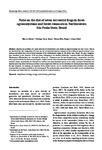Use este identificador para citar ou linkar para este item:
http://www.alice.cnptia.embrapa.br/alice/handle/doc/1021917Registro completo de metadados
| Campo DC | Valor | Idioma |
|---|---|---|
| dc.contributor.author | MENIN, M. | pt_BR |
| dc.contributor.author | SANTOS, R. S. | pt_BR |
| dc.contributor.author | BORGES, R. E. | pt_BR |
| dc.contributor.author | PIATTI, L. | pt_BR |
| dc.date.accessioned | 2015-08-13T11:11:11Z | pt_BR |
| dc.date.available | 2015-08-13T11:11:11Z | pt_BR |
| dc.date.created | 2015-08-13 | pt_BR |
| dc.date.issued | 2015 | pt_BR |
| dc.identifier.citation | Herpetology Notes, Czech Republic, v. 8, p. 401-405, 2015. | pt_BR |
| dc.identifier.issn | 2071-5773 | pt_BR |
| dc.identifier.uri | http://www.alice.cnptia.embrapa.br/alice/handle/doc/1021917 | pt_BR |
| dc.description | Anurans are predators of a great diversity of invertebrates, but studies on agroecosystems are very scarce. Herein we described the diet composition of seven species of terrestrial anurans captured in three different agroecosystems (corn, soybean and rubber tree) and in forest remnants of the Northwestern region of São Paulo state, Brazil. Ten prey categories were identified in the stomachs of 80 specimens belonging to the families Bufonidae, Leptodactylidae and Microhylidae. Hymenoptera (Formicidae) was consumed by all species. Coleoptera was the most frequent item, consumed by six of the even species followed by Araneae and Isoptera. Isoptera was the most abundant item followed by Formicidae, Coleoptera and Araneae. Adults and juveniles of Physalaemus nattereri, the most abundant species in our study, consumed Formicidae and Isoptera more than other food items and there is not a significant difference in the abundance of consumed prey items between the age categories. In summary, the majority of the studied species can be considered generalists predators and, probably, consumed the prey items available in the environment. The most abundant species found in our study can be considered here as having a specialized diet, by consuming social insects in great frequency. | pt_BR |
| dc.language.iso | eng | eng |
| dc.rights | openAccess | eng |
| dc.subject | Anuro terrestre | pt_BR |
| dc.subject | Terrestrial anurans | pt_BR |
| dc.subject | Rubber tree | pt_BR |
| dc.subject | Jaboticabal (SP) | pt_BR |
| dc.subject | São Paulo | pt_BR |
| dc.subject | Cultura | pt_BR |
| dc.subject | Insectos sociales | pt_BR |
| dc.subject | Maiz | pt_BR |
| dc.subject | Nutrición animal | pt_BR |
| dc.subject | Semillas de soja | pt_BR |
| dc.subject | Agroescosistemas | pt_BR |
| dc.subject | Zea maiz | pt_BR |
| dc.subject | Anfibios | pt_BR |
| dc.title | Notes on the diet of seven terrestrial frogs in three agroecosystems and forest remnants in Northwestern São Paulo State, Brazil. | pt_BR |
| dc.type | Artigo de periódico | pt_BR |
| dc.date.updated | 2017-06-21T11:11:11Z | pt_BR |
| dc.subject.thesagro | Nutrição animal | pt_BR |
| dc.subject.thesagro | Anfíbio | pt_BR |
| dc.subject.thesagro | Dieta | pt_BR |
| dc.subject.thesagro | Hábito alimentar | pt_BR |
| dc.subject.thesagro | Inseto | pt_BR |
| dc.subject.thesagro | Milho | pt_BR |
| dc.subject.thesagro | Soja | pt_BR |
| dc.subject.thesagro | Glycine max | pt_BR |
| dc.subject.thesagro | Seringueira | pt_BR |
| dc.subject.thesagro | Hevea brasiliensis | pt_BR |
| dc.subject.thesagro | Caucho | pt_BR |
| dc.subject.nalthesaurus | Animal nutrition | pt_BR |
| dc.subject.nalthesaurus | Amphibians | pt_BR |
| dc.subject.nalthesaurus | Social insects | pt_BR |
| dc.subject.nalthesaurus | Agroecosystems | pt_BR |
| dc.subject.nalthesaurus | Corn | pt_BR |
| dc.subject.nalthesaurus | Soybeans | pt_BR |
| dc.description.notes | Published online on 12 August 2015. | pt_BR |
| riaa.ainfo.id | 1021917 | pt_BR |
| riaa.ainfo.lastupdate | 2017-06-21 | pt_BR |
| dc.contributor.institution | Marcelo Menin, Universidade Federal do Amazonas; RODRIGO SOUZA SANTOS, CPAF-AC; Rinneu Elias Borges, Universidade do Rio Verde; Liliana Piatti, Universidade de São Paulo. | pt_BR |
| Aparece nas coleções: | Artigo em periódico indexado (CPAF-AC)  | |
Arquivos associados a este item:
| Arquivo | Descrição | Tamanho | Formato | |
|---|---|---|---|---|
| 25701.pdf | 300,08 kB | Adobe PDF |  Visualizar/Abrir |









